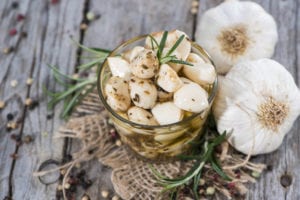Written by Taylor Woosley, Staff Writer. 4-week garlic supplementation significantly improved best-corrected visual acuity and reduced central macular thickness compared to placebo.
 Diabetic retinopathy (DR) is the most common complication of diabetes mellitus and is the leading causse of visual loss in the elderly1. The initial stage of DR involves altered metabolic pathways leading to oxidative stress and the development of neurodegeneration2. The main pathophysiology of DR is various changes caused by hyperglycemia, including the thickening of retinal capillary basement membrane, increased retinal vascular permeability, and the release of various vasoactive substances, leading to neovascularization3.
Diabetic retinopathy (DR) is the most common complication of diabetes mellitus and is the leading causse of visual loss in the elderly1. The initial stage of DR involves altered metabolic pathways leading to oxidative stress and the development of neurodegeneration2. The main pathophysiology of DR is various changes caused by hyperglycemia, including the thickening of retinal capillary basement membrane, increased retinal vascular permeability, and the release of various vasoactive substances, leading to neovascularization3.
Garlic and its bioactive compounds, such as phenolic compounds and saponins, have shown excellent health-promoting properties4. The main ingredient in garlic is allicin which can reduce reactive oxygen species and play a significant role in immune enhancement5. Trials using garlic on type 2 DM patients have reported significantly reduced glycaemia and lipid metabolism, while improving insulin sensitivity6.
Afarid et al. conducted a double-blind randomized study to analyze the effectiveness of garlic in the control of DR and diabetic macular edema (DME). Study inclusion consisted of diabetic subjects with completed spectral-domain optical coherence tomography (SD-OCT) and those with a central macular thickness (CMT) of more than 350 µm. 91 diabetic participants were divided into either the treatment group (garlic tablet) (n=45) or the placebo group (n=46) and consumed two tablets a day with lunch for four weeks. The garlic tablet contained 500 mg garlic (allium sativum) granulated powder with 2-3 mg of allicin. All subjects continued receiving treatment of DME by intravitreal injection of bevacizumab throughout the study.
Baseline measurements of intraocular pressure (IOP), best-corrected visual acuity (BCVA), refraction, slit-lamp biomicroscopy, and fundoscopic examination were completed by an unrelated ophthalmoscope. Primary outcomes included changing values of the logarithm of the minimum angle of resolution (logMAR) and the CMT (µm). Secondary outcomes included changing IOP and any general or ocular complication. Mann-Whitney test was utilized to analyze the treatment group vs. control.
The mean age of participants was 61.91 ± 6.35 years in the garlic group and 60.50 ± 7.04 years in the placebo group (P value: 0.319). A significant number of participants were female in both the treatment and placebo group (83.1% vs. 56.9%, respectively), resulting in a significant difference (P value: 0.002). No significant difference relating to mean fasting blood sugar and HbA1c levels were noted between the two groups. 59 eyes in the garlic group and 58 in the placebo group were included in study analysis. Significant findings of the study are as follows:
- At a four-week follow-up, the garlic group showed a more significant improvement in BCVA in comparison with the control group (0.18 decrease mean logMAR value in the garlic group compared to 0.06 in the placebo group) (P value= 0.027).
- After four weeks of treatment, subjects in the garlic group had more of a decrease in CMT compared with placebo (102.99 µm decrease in the garlic group compared to 52.67 µm in the placebo group). However, the results were not statistically significant (P value: 0.094).
- At week 4, the mean IOP had decreased in the garlic group by 1.03 mmHg (P value: 0.024) and increased by 0.3 mmHg (P value: 0.468) in the placebo group. The IOP decrease in the garlic group was statistically significant (P value= 0.036).
Results of the double-blind randomized study shows that 4-week garlic supplementation improved visual acuity and reduced CMT. Findings support the use of garlic as a complementary treatment for DME. Study limitations include the short duration of the study and poor follow-up of patients during the COVID-19 pandemic.
Source: Afarid, Mehrdad, Elham Sadeghi, Mohammadkarim Johari, Ehsan Namvar, and Fatemeh Sanie-Jahromi. “Evaluation of the effect of garlic tablet as a complementary treatment for patients with diabetic retinopathy.” Journal of Diabetes Research 2022 (2022).
© 2022 Mehrdad Afarid et al. This is an open access article distributed under the Creative Commons Attribution License, which permits unrestricted use, distribution, and reproduction in any medium, provided the original work is properly cited.
Click here to read the full text study.
Posted July 3, 2023.
Taylor Woosley studied biology at Purdue University before becoming a 2016 graduate of Columbia College Chicago with a major in Writing. She currently resides in Glen Ellyn, IL.
References:
- Wang W, Lo ACY. Diabetic Retinopathy: Pathophysiology and Treatments. Int J Mol Sci. Jun 20 2018;19(6)doi:10.3390/ijms19061816
- Lin KY, Hsih WH, Lin YB, Wen CY, Chang TJ. Update in the epidemiology, risk factors, screening, and treatment of diabetic retinopathy. J Diabetes Investig. Aug 2021;12(8):1322-1325. doi:10.1111/jdi.13480
- Kang Q, Yang C. Oxidative stress and diabetic retinopathy: Molecular mechanisms, pathogenetic role and therapeutic implications. Redox Biol. Oct 2020;37:101799. doi:10.1016/j.redox.2020.101799
- Ansary J, Forbes-Hernández TY, Gil E, et al. Potential Health Benefit of Garlic Based on Human Intervention Studies: A Brief Overview. Antioxidants (Basel, Switzerland). Jul 15 2020;9(7)doi:10.3390/antiox9070619
- Sanie-Jahromi F, Zia Z, Afarid M. A review on the effect of garlic on diabetes, BDNF, and VEGF as a potential treatment for diabetic retinopathy. Chin Med. Feb 17 2023;18(1):18. doi:10.1186/s13020-023-00725-9
- Melino S, Leo S, Toska Papajani V. Natural Hydrogen Sulfide Donors from Allium sp. as a Nutraceutical Approach in Type 2 Diabetes Prevention and Therapy. Nutrients. Jul 12 2019;11(7)doi:10.3390/nu11071581
